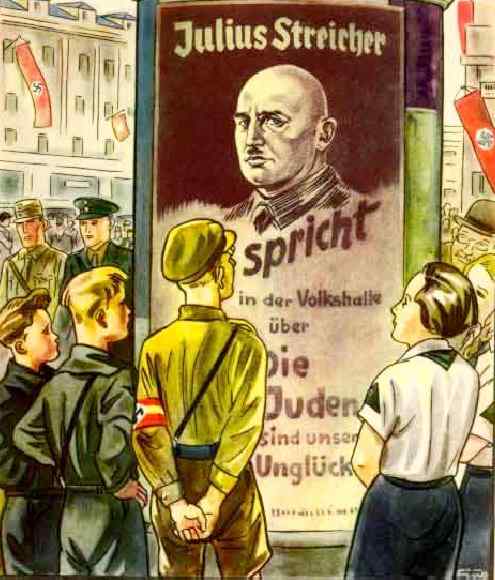
NAZI Education: Books

Figure 1.--One example of this literature is Der Giftpilz (Toadstool), a collection of stories about Jews published by the vicious anti-semite Julius Streicher who operated a publishing house. The caption is a quotation from Streicher, "He who fights the Jews battles the Devil." It went with an article "Without solving the Jewish question no salvation for mankind". The children are wearing their Hitler Youth uniforms. The poster is on a Litfaßsäule
|
|
The NAZIs, upon seizing power, began strictly censorsing what was published in Germany. Books were one of the first casulties of the NAZI regime which organized mass burnings of books written by Jews or expressing "degebnerate, "un-Germkan views. The NAZIs organized Wagnerian spectacles, marching in longlines by torchlight, singing Party songs, and chanting the twelve "theses,"--their manifesto for the "purification" of German literature and thought. The NAZIs proceeded to rewrite German textbooks and unabashedly use schoolbooks for propaganda purposes. They also introduced their major themes into children's books.
Books were one of the first casulties of the NAZI regime when Hitler seixed power in 1933. The NAZIs organized mass burnings of books written by Jews or expressing objectional ideas. Virtually all books by Jewish authors were destroyed. Hitler Youth members enthusiastically committed masterpieces of the German language as well as many foreign texts to huge bonfires. The book burnings were carefully prepared. The NAZIS seized power in January 1933. Throughout the spring of 1933, NAZI student organizations, professors, and librarians compiled an extensive lists of books they determined to be "entartet" (degenerate) and should not be read by decent Germans. NAZI SA Stormtroopers and student groups armed with this list on the night of May 10, 1933, broke into libraries and bookstores all over Germany. They organized Wagnerian spectacles, marching in longlines by torchlight, singing Party songs, and chanting the twelve "theses,"--their manifesto for the "purification" of German literature and thought. They then threw the seized books on to huge bonfires. More than 20,000 books were burned on May 10 at the Berlin Opernplatz book burning alone. Many were works of Jewish authors such as Thomas Mann, Erich Maria Remarque, Albert Einstein and Sigmund Freud. Most were by non-Jewish writers, including famous American (Jack London, Ernest Hemingway, and Sinclair Lewis), English (H.G. Wells), and French writers who expressed idea differing from the NAZI world view. The choice of degenerate authors provides a terrifying insight into the NAZI mindset. One such author was Helen Keller, the deaf-mute who became a writer. (The handicapped in German were to be targeted by the NAZIs as part of a eugenics program several years before the Holocaust.) Public and private libraries and book stores were advised to ensure that they did not have the "degenerate", "un-German" books.
Censorship
The NAZIs, upon seizing power, seized control of all forms of communication in Germany.
They began to strictly censor what was published in Germany. This extended to newspapers, magazines, and books. Books writen by Jews and a long list of other works were "blacklisted" Reich Propaganda Minister Josef Goebbels and removed from circulation as "alien" or "decadent" literature. The NAZI censorship program was conducted by Philipp Bouhler, the Director of the Party Censorship Office. This of course included both school textbooks and children's literature.
The NAZIs proceeded to unabashedly use schoolbooks for propaganda purposes. Bernhard Rust, the Minister of Education, saw the purpose of school textbooks was to achieve "the ideological education of young German people, so as to develop them into fit members of the national community ... ready to serve and to sacrifice". Censorship Director Bouhler worked closely with Reich Education Minister Bernhard Rust to revise German textbooks. Even the NAZIs could not immediately replace all the country's textbooks. Large numbers of text books were destroyed in 1933 leading to shortages of texts for several years. Publishers initially made only minor changes in existing texts. They often reprinted existing with the addition of swastikas and NAZI Party slogans. Rust by the late 1930s had overseen the repacement of school books that had been completely rewritten by authors approved by the Ministry of Education and members of the National Socialist Teachers’ Association. The new text and carefully chosen illustrations were designed to support major NAZI tenants and were blatantly used to promote the Party program.
The NAZIs also introduced their major themes into children's books. Children's literature in the Third Reich was geared towards teaching children at an early age the evils of the Jewish race. One example of this literature is is Der Giftpilz (Toadstool) was published by the vicious anti-semite Julius Streicher who operated a publishing house. Some German schools even used this book to teach young children how to read, although orignally published as a textbook.
Sources
The Library of Congress' children's book holdings include a unique collection of Japanese-language children's books published prior to and during World War II, children's
books published in Nazi Germany, and a small collection of rare children's books published in the USSR during the 1920s and 1930s.
HBC-SU

Related Chronolgy Pages in the Boys' Historical Web Site
[Main Chronology Page]
[The 1910s]
[The 1920s]
[The 1930s]
[The 1940s]
Navigate the German school pages
[Return to the Main NAZI education page]
[Main NAZI school uniform page]
[Main school uniform national page]
[Main German school uniform page]
[Imperial Germany]
[Weimar Republic]
[NAZI era]
[Post-war Years]
[Modern Germany]
Navigate the Relate Boys Historical Clothing Style Pages
[Main country page]
[Long pants suits]
[Short pants suits]
[Lederhosen]
[Kneesocks]
[Eton suits]
[Jacket and trousers]
[Blazer
[School sandals]
Navigate the Boys' Historical Clothing School Uniform Pages
[Main School Uniform Page]
[Australia]
[England]
[France]
[Germany]
[Italy]
[Japan]
[New Zealand]
[Scotland]
[United States]
Navigate the Boys' Historical Clothing Web Page
[Introduction]
[Activities]
[Biographies]
[Chronology]
[Clothing styles]
[Countries]
[Bibliographies]
[Contributions]
[Essays]
[FAQs]
[Glossaries]
[Images]
[Links]
[Registration]
[Tools]
[Boys' Clothing Home]
Created: February 27, 1999
Last updated: 4:16 AM 5/3/2009




